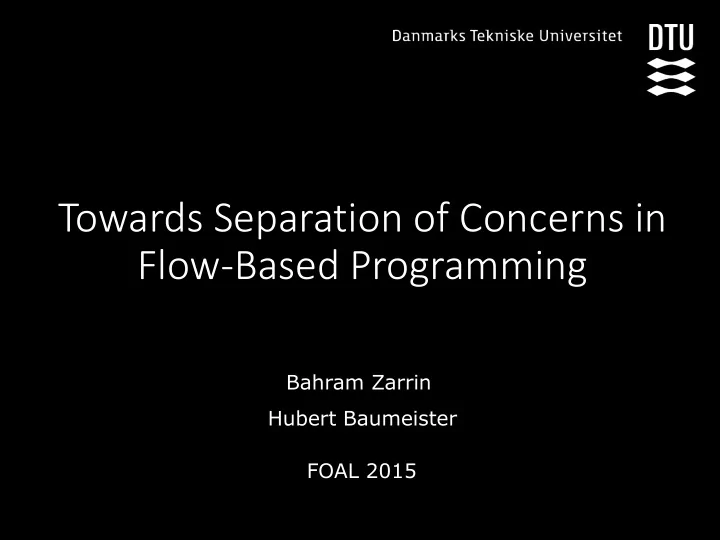

Towards Separation of Concerns in Flow-Based Programming Bahram Zarrin Hubert Baumeister FOAL 2015
Flow Based Programming • Invented by J. Paul Morrison in the early 1970s • Models software systems as a directed graph of predefined processes which run asynchronously and exchange data through input and output ports. in B o1 in2 o1 A D in1 o2 in C o1 • Atomic or composite process, ports, connections, scheduler • Implementation (C#FBP, CppFBP, JavaFBP)
Motivation • There are concerns in software systems which cannot be modularized well in FBP. • Examples • Logging • Life Cycle Assessment • Costing
Logging P1 P2 P3 a)
Logging Log Log P1 Log Log Log P2 P3 b)
Waste Management Modeling
Waste Management Modeling WP1 WP2 WP3 a)
Waste Management Modeling + + LCA LCA LCA WP1 WP2 WP3 b)
Cross-Cutting Problem in FBP • Tangled and scattered process definitions. • On the one hand, one process addresses several concerns. On the other hand, the implementation of a single concern is scattered through many places in the other process definitions. Log Log P1 Log Log Log P2 P3 b) + + LCA LCA LCA WP1 WP2 WP3 b)
Extending FBP with Aspect-Oriented Concepts • Aspect-Oriented Flow-Based Programming (AOFBP) • Join Point Model and Pointcut Language • Advice • Weaving • Tool Support • AOC#FBP
AOFBP Join Point Model aspect A pointcut P1 P2 P3 P4 P5
AOFBP Pointcut Language <PortDesignator> ::= inPort (<String>,<String>,<String>) |outPort (<String> , <String> , <String>) |port (<String> , <String> , <String>) <LevelDesignator> ::= level (<String>) <ContextDesignator> ::= child (<PointcutExp> , <String>) |parent (<PointcutExp> , <String>) <ConDesignator> ::= inCon (<PointcutExp> , <String>) |outCon (<PointcutExp> , <String>) <Designator> ::= procType (<String>) |<PortDesignator>|<LevelDesignator> |<ContextDesignator>|<ConDesignator> <ParExpr> ::= (<PointcutExp>) <UnNot> ::= ^<PointcutExp> <BinAnd> ::= <PointcutExp> & <PointcutExp> <BinOr> ::= <PointcutExp > ‘|’ < PointcutExp> <BinExpr> ::= <BinAnd>|<BinOr> <PointcutExp> ::= <Designator> |<Identifier>|<ParExpr>|<UnNot>|<BinExpr> procType("*foo") & inPort("*","int","2") & inCon(procType("*foo"),"2..4")
AOFBP Advice A P P
AOFBP Advice Before After Around A A A • Observer P P P P A A A P • Adaptor A • Collector P1 P2 Pn
AOFBP Network Definition <Attribute> ::= name |type |parent <PortFilter> ::= in (<String> , <String>) |out (<String> , <String>) <PortCtor> ::= <Identifier> (<Type>) <ProcRef> ::= <Identifier>() <Param> ::= <Identifier> = <Value> <ParamList> ::= <ParamList> , <Param> | <Param> <ProcCtor> ::= <Identifier> (<ComponentID>) |<Identifier> (<ComponentID> : <ParamList>) <ProcExp> ::= <ProcRef> |<ProcCtor> |<Connection> |this <Value> ::= <ProcExp> [<Attribute>] |<Number> |<String> |<Object> <InExp> ::= <Identifier> <ProcExp> |<PortCtor> <OutExp> ::= <ProcExp> <Identifier> |<ProcExp> <PortFilter> |<PortCtor> |<Value> <Connection> ::= <OutExp> -> <InExp> <Network> ::= <Network> ; <Connection> | <Connection> <NetworkDef> ::= network <ComponentID> <Network> end network sample "some data" -> X P1(Componenet1); P1() Y -> Z P2(Component2) K -> R P3(Component3); end
AOFBP Aspect <NamedPortFilter> ::= <PortFilter> as <Identifier> <PortFilterList> ::= <PortFilterList> , <NamedPortFilter> |<NamedPortFilter> <AdviceType> ::= before |after |around <Collector> ::= collector <Identifier> (<PortFilterList>) : <PointcutExp> <Network> end <Observer> ::= observer <Identifier> <AdviceType> : <PointcutExp> <Network> end <Adapter> ::= adapter <Identifier> <AdviceType> : <PointcutExp> <Network> end <AdviceDef> ::= <Observer>|<Adapter>|<Collector> <PonitCutDef> ::= pointcut <Identifier> : <PointcutExp> <Statement> ::= <PonitcutDef>|<AdviceDef> <StatementList> ::= <StatementList> ; <Statement> |<Statement> <Aspect> ::= aspect <Identifier> <StatementList> end
AOFBP Architecture AOFBP# Engine AOFBP# Scheduler AOFBP# AOFBP# Aspect files Aspect files Aspect files Aspects Weaver C#FBP Engine C#FBP Network C#FBP Aspect files Aspect files Scheduler files Networks C#FBP Components C#
Examples aspect logging pointcut all_processes: procType("*"); observer logger before : all_processes this in ("*","*") -> arguments L(Logger : name= this [name], type= this [type]) end end
Examples aspect LCA pointcut p: inPort("*","waste","1..*"); observer process_LCA () before : p & ^isComposite this in ("*","waste") -> WASTE_IN lca_process( LCAComponent: p_name= this [name], p_type = this [type]); lca_process() LCA -> LCA (LCA) end ; collector composite_LCA( out ("LCA","LCA") as inventory): p & isComposite inventory -> values AP(aggregation); AP() result -> LCA (LCA) end end
Related Work • At the moment none of the FBP implementations have addressed the cross-cutting-concerns and provided mechanisms to implement them. PyF, DSPatch, Pypes , and NoFlo. • AO4BPEL (A. Charfi and M. Mezini. 2007) improves the modularity and increases the flexibility of Web Service composition. • Composition Filters (L. Bergmans and M. Aksit. 2001) provides separation of concerns for object-based systems.
Conclusion • Address the cross-cutting concerns in FBP. • Propose an aspect-oriented approach to FBP called AOFBP to support aspect-oriented concepts in FBP. • Provide means to specify sub graphs of the processes in a network as join points and to add mechanisms for advice to substitute the subgraph with alternatives as future works.
Recommend
More recommend